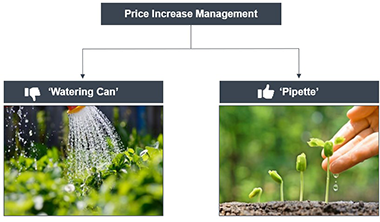Steadily high inflation is putting pressure on medical technology companies around the world; costs for raw materials, transportation, warehousing, wages, and more continue to rise. Eighty-seven percent of medical technology companies are feeling these pressures very keenly.[1] Additionally, in Europe, the Medical Device Regulation (MDR) is adding to the already high hurdles. Due to the necessary but lengthy certification process, a high percentage of companies have not yet received the new MDR certificates. At the same time, MDR implementation is leading to a reduction in portfolios; a large portion of the companies surveyed by the Obelis Group do not intend to convert relevant parts of their portfolio to MDR.[2] The result of all this is that sales are collapsing rapidly.
Plan, Calculate, Enforce: Systematic Price Adjustment
In the last year, successful price increases became essential for many MedTech companies as it was the only way they could ensure their economic viability. However, many leaders now realize that their companies were not optimally prepared for the implementation of such price adjustments, which highlighted several challenges:
- Lack of a predefined price adjustment process with clear responsibilities.
- More complex costing processes than those required in the past.
- The sales department is often not systematically prepared.
Prices are a highly sensitive topic. Therefore, a successful price increase is anything but trivial, and unfortunately, there is no universal scheme. The following tips provide guidance for proceeding successfully.
Step 1: Plan Price Adjustments
Price increases are often initiated hastily due to acutely increased cost pressure. However, this leads to decisions based on suboptimal information and does not give the sales organization a chance to prepare. Predefined triggers for price adjustments, such as cost increases for intermediate products or raw materials, should be defined in advance. The processes and responsibilities that then follow should also be defined in advance.
Uncertainty usually surrounds the amount of the price adjustment. The enormous earnings potential is contrasted with the concern of lost sales. Before the price adjustment can be carried out, all important information should be compiled. Here it is advisable to involve all relevant market experts of the company and to use analyses of the market and competitive environment to overcome the uncertainty. Internal sales experts, in particular, know the market and the company’s own customer base and are thus the strongest anchor points.
Step 2: Calculate the Price Adjustment
At first glance, nothing seems simpler than increasing your entire portfolio uniformly when prices are adjusted. However, this pragmatic approach entails significant risks. For example, commodity product prices can be increased too much so that they are no longer attractive to customers. Customers with a willingness to pay significantly more, on the other hand, are only charged slightly more. In addition, countries or regions are not addressed according to their local price levels.

These problems are solved by differentiated price adjustment. The defined price increase—for example 10%—is differentiated by region, customer and product so that, for example, certain customer types in a defined region receive a greater price increase (e.g. +15%) for the same product than other customer types in other regions receive for the same product (e.g. +5%).
A scoring model is used to carry out this differentiation. Points are distributed according to the above criteria (e.g., region, customer group, product), indicating how much the price increase should be allocated to each segment:
- Countries and regions: The U.S., for example, scored higher than Latin American countries, such as Brazil or Mexico, due to its higher incomes. The U.S. could then receive three points in a scoring, Brazil two points and Mexico one point.
- Customer groups: Producers of proprietary pharmaceuticals may be willing to pay more because they often have more margin room than, for example, producers of generics with very low margins. The former then receive a higher score and the latter a lower score.
- Products: The same principle can then be applied to proprietary products. Patent-protected, poorly substitutable products with few competitors in the market receive a higher score than easily substitutable commodities with many competitors.
A total score is then calculated for all ratings, and the price increase (e.g., +10% on average) is allocated to regions, customers and products according to this score and with a predefined maximum spread (e.g., from +5% to +20%).
Step 3: Prepare for Price Adjustment
When the time has come for a price adjustment, this must be clearly communicated internally. It is also important for management to show that it stands behind the sales department. The sales team should be clearly instructed that the sales focus is on profitability and which segments (unprofitable) sales may be given up if necessary.
In the event of escalation on the part of the customer, it is important to stand behind the sales department. Signaling the customer that they only need to move higher up in the hierarchy to get a better price will undermine your sales team and implementation of the price increase.
For many sales employees, price negotiations are unpleasant. This is precisely why they require dedicated preparation. If the sales department stumbles during customer contact, the implementation of a price adjustment is quickly put in jeopardy. Typical customer queries and useful argumentation chains must therefore be clarified in advance. It can be helpful to show the customer what efforts are being made to reduce the increased costs, for example through innovations in production. It should also be communicated how the solution will help them optimize their internal costs, for example through faster ROI.
In such challenging times, such as those currently caused by inflation as well as the implementation of the EU MDR, MedTech companies often cannot avoid a well thought-out price adjustment in order to be successful in the long run.
References:
[1] DIHK (2022). Gesundheitswirtschaft unter Druck. https://www.dihk.de/resource/blob/73350/4912206cdf7717fd3e770a3927f58537/gesundheitsreport-fruehsommer-2022-data.pdf
[2] Obelis Group (2022): What are the effects of the implementation of MDR on the EU medical device market? https://www.obelis.net/news/what-are-the-effects-of-the-implementation-of-mdr-on-the-eu-medical-device-market/




